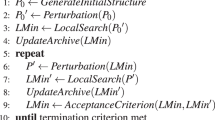Abstract
Computational models of protein-protein docking that incorporate backbone flexibility can predict perturbations of the backbone and side chains during docking and produce protein interaction models with atomic accuracy. Most previous models usually predefine flexible regions by visually comparing the bound and unbound structures. In this paper, we propose a general method to automatically identify the flexible hinges for domain assembly and the flexible loops for loop refinement, in addition to predicting the corresponding movements of the identified active residues. We conduct experiments to evaluate performance of our approach on two test sets. Comparison of results on test set I between algorithms with and without prediction of flexible regions demonstrate the superior recovery of energy funnels in many target interactions using the new loop refinement model. In addition, our decoys are superior for each target. Indeed, the total number of satisfactory models is almost double that of other programs. The results on test set II docking tests produced by our domain assembly method also show encouraging results. Of the three targets examined, one exhibits energy funnel and the best models of the other two targets all meet the conditions of acceptable accuracy. Results demonstrate that the automatic prediction of flexible backbone regions can greatly improve the performance of protein-protein docking models.



Similar content being viewed by others
Notes
The parentheses operator is prior to AND operator
References
Uetz P, Giot L, Cagney G, Mansfield TA, Judson RS, Knight JR (2000) A comprehensive analysis of protein-protein interactions in Saccharomyces cerevisiae. Nature 403:623–627
Gavin AC, Bosche M, Krause R, Grandi P, Marzioch M, Bauer A (2002) Functional organization of the yeast proteome by systematic analysis of protein complexes. Nature 415:141–147
Berman HM, Bhat TN, Bourne PE, Feng Z, Gilliland G, Weissig H, Westbrook J (200) The Protein Data Bank and the challenge of structural genomics. Nat Struct Biol 7:957–959
Anfinsen CB (1973) Principles that govern the folding of protein chains. Science 181:223–230
Katchalski-Katzir E, Shariv I, Eisenstein M, Friesem A, Aflalo C, Vakser I (1992) Molecular surface recognition: determination of geometric fit between protein and their ligands by correlation techniques. Proc Natl Acad Sci USA 89:2195–2199
Chen R Weng ZP (2002) Docking unbound proteins using shape complementarity, desolvation, and electrosatics. Proteins 47:281–294
Gray JJ, Moughon S, Wang C, Kuhlman OSB, Rohl CA, Baker D (2003) Protein-protein docking with simultaneous optimization of rigid-body displacement and side-chain conformations. J Mol Biol 331:281–299
Wang C, Schueler-Furman O, Baker D (2005) Improved side-chain modeling for proteinprotein docking. Protein Sci 14:1328–1339
Janin J, Henrick K, Moult J, Eyck LT, Sternberg MJ, Vajda S (2003) CAPRI: a critical assessment of predicted interactions. Proteins 52:2–9
Mendez R, Leplae R, De Maria L, Wodak SJ (2003) Assessment of blind predictions of protein-protein interactions: current status of docking methods. Proteins 52:51–67
Mendez R, Leplae R, Lensink MF, Wodak SJ (2005) Assessment of CAPRI predictions in rounds 3–5 shows progress in docking procedures. Proteins 60:150–169
Bastard K, Prevost C, Zacharias M (2006) Accounting for loop flexibility during proteinprotein docking. Proteins 62:956–969
Schneidman-Duhovny D, Nussinov R, Wolfson HJ (2007) Automatic prediction of protein interactions with large scale motion. Proteins 69:764–773
Emekli U, Schneidman-Duhovny D, Wolfson HJ, Nussinov R, Haliloglu T (2008) HingeProt: automated prediction of hinges in protein structures. Proteins 70:1219-1227
Wang C, Bradley P, Baker D (2007) Protein-protein docking with backbone flexibility. J Mol Biol 373:503–519
Rossmann MG, Liljas A (1974) Recognition of structural domains in globular proteins. J Mol Biol 85:177–181
Siddiqui AS, Barton GJ (1995) Continuous and discontinuous domains: an algorithm for the automatic generation of reliable protein domain definition. Protein Sci 4:872-884
Davis IW, Arendall WB, Richardson DC, Richardson JS (2006) The backrub motion: how protein backbone shrugs when a sidechain dances. Structure 14:265–274
Smith AC, Kortemme T (2008) Backrub-like backbone simulation recapitulates natural protein conformational variability and improves mutant side-chain rediction. J Mol Biol 380:742–756
Friedland GD, Linares AJ, Smith CA Kortemme T (2008) A simple model of backbone flexibility improves modeling of side-chain conformational variability. J Mol Biol 380:757–774 (2008)
Chen R, Mintseris J, Janin J, Weng Z (2003) A protein-protein docking benchmark. Proteins 52:88–91 (2003)
Hwang H, Vreven T, Janin J, Weng Z (2010) Protein-protein docking benchmark version 4.0. Proteins 78:3111–3114 (2010)
Kabsch W, Sander C (1983) Dictionary of protein secondary structure: Pattern recognition of hydrogen-bonded and geometrical features. Biopolymers 22:2577–2637
Jiang HY, Blouin C (2006) Ab initio construction of all-atom loop conformations. J Mol Model 12:221–228 (2006)
Greene LH Higman VA (2003) Uncovering network systems within protein structures J Mol Biol 334:781–791
Amitai G, Shemesh A, Sitbon E, Shklar M, Venger DNI, Pietrokovski S (2004) Network analysis of protein structures identifies functional residues. J Mol Biol 344:1135–1146 (2004)
Maiorov VN, Abagyan RA (1997) A new method for modeling large-scale rearrangements of protein domains. Proteins 27:410–424
Acknowledgements
Great thanks to the developers of Rosetta3.1.
Author information
Authors and Affiliations
Corresponding author
Additional information
Supported by National Natural Science Foundation of China under the grant number 60970055, 61170125. Qiang Lü
Rights and permissions
About this article
Cite this article
Luo, X., Lü, Q., Wu, H. et al. Automatic prediction of flexible regions improves the accuracy of protein-protein docking models. J Mol Model 18, 2199–2208 (2012). https://doi.org/10.1007/s00894-011-1231-0
Received:
Accepted:
Published:
Issue Date:
DOI: https://doi.org/10.1007/s00894-011-1231-0




